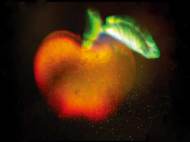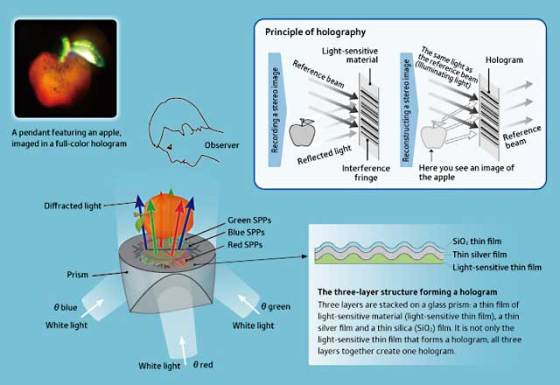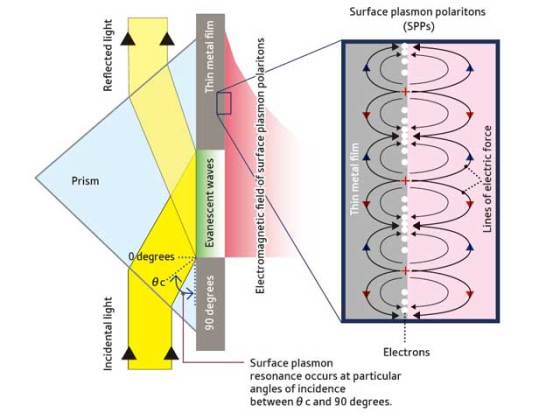Using surface plasmons to create full-color holograms
 Unlike various visions of hologram application described in sci-fi tales, currently used technology used to show holograms usually allows projection of a red or blue stereoscopic. Notable progress in nanotechnology in recent years led to advances research on surface plasmons which allowed a group of researchers from RIKEN institute to develop a novel holography principle able to employ white light to reconstruct a full-color three-dimensional object.
Unlike various visions of hologram application described in sci-fi tales, currently used technology used to show holograms usually allows projection of a red or blue stereoscopic. Notable progress in nanotechnology in recent years led to advances research on surface plasmons which allowed a group of researchers from RIKEN institute to develop a novel holography principle able to employ white light to reconstruct a full-color three-dimensional object.
The hologram they managed to in an experiment is a pendant featuring the image of an apple which measures 3.8 cm (1.5 inches) in length and 2.6 cm (1 inch) in width. Currently devised method limits the viewing angles for stereo images about 25 degrees both vertically and laterally. Once the pre-recorded hologram is illuminated with ordinary light, the light is diffracted by the interference fringe making it looks as if the object is actually present.
Unlike previously devised methods of hologram reproduction which involved a prism and a thin metal film, the hologram developed by RIKEN researchers comprises of a thin film of light- sensitive material, a 55 nm thin silver film and a thin silica (SiO2) film stacked on a glass prism with 25 nm high undulations that correspond with the interference fringes for the three colors R, G and B on all three layers which are several hundred nanometers thick in total.
“Since the three primary colors of light – red, green and blue (RGB) – can be extracted from white light, stereoscopic images are reconstructed from holograms in the respective colors, and the three stereo images are superposed to obtain a combined full-color image”, said Chief Scientist Satoshi Kawata of RIKEN, the head of the Nanophotonics Laboratory at the Advanced Science Institute in Wako.
The key to successfully extracting RGB separately from white light resides in superposing a thin silver film onto light-sensitive material in a way that excites surface plasmon polaritons (SPPs) on the thin film. The right combination of film thickness, material, incident angle of light, and wavelength of light, leads to surface plasmon resonance is seen at given parameters of. In the case of white light, which is a blend of many different wavelengths, the angle of incidence varies as a function of wavelength for RGB.
“The three angles of incidence of white light (θ red, θ green, θ blue) have been adjusted in advance to allow surface plasmon resonance to occur for each of the R, G and B colors”, said Miyu Ozaki, a visiting scientist of RIKEN who is involved into the development. “A beam of white light applied in three directions excites the SPPs in each color, and the resulting electromagnetic fields are holographically diffracted to reconstruct a stereo image. Looking at it from above, the viewer can see a full-color stereo image.”
In order to record information onto material, the researchers used laser with 2 beams. The illumination beam lights up the object, and light reflected by the object is applied to a light-sensitive material, such as photo film. At the same time, another light source called a reference beam is superposed onto the photo-sensitive material, and interference of 2 beams produces a pattern of dark and bright bands that correspond to the light scattered by the object.
“This achievement will find applications in three-dimensional display devices in the future”, said Ozaki. “In the case of holograms generated using surface plasmons, white light alone serves as the incidental light, and beams can be applied from behind, so our system can be utilized in small devices such as smart phones.”
The researchers plan to improve the system in order to reproduce holograms of larger objects and to develop a system capable to project moving pictures. Kawata has been expanding his research area to encompass nanophotonics and plasmonics, and he is now focusing on deep ultra-violet ray plasmonics where he expects new revelations that could lead to various breakthroughs in science.
For more information, read the report pulbished in the AAAS Science: “Surface-Plasmon Holography with White-Light Illumination“











Leave your response!